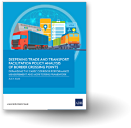The World’s Struggling Supply Chains Need Greater Transparency to Speed Recovery
Greater transparency is required to make global trade and supply chains more reliable and to ensure sustainability and social standards are met. But that is easier said than done.
Current blockages in some supply chains are raising questions about the complexity and importance of these networks.
Is a given supply chain robust enough to keep operating through a crisis, or even through a minor strain in the chain? Are workers throughout the chain treated fairly? Do all companies in a chain maintain proper environmental standards? In too many cases, answers to these and similar questions are often unobtainable at the moment.
We lack the tools and mechanisms to fix supply chains and ensure environmental and social standards are met in global trade and supply chains. Without a clear understanding of supply chains, without the ability to map every component part of the production and distribution process, the public and private sectors cannot identify and address bottlenecks that impede the efficient production and delivery of critical goods. Nor can we verify and monitor if environmental and social standards are being met.
Digitalization is key. To that end, the ADB-backed Digital Standards Initiative is bringing together disparate global efforts to develop and adopt the standards and protocols needed to drive inter-operability and create seamless trade and supply chains, from exporters, shippers, ports, customs, and warehousing to importers and distributors. The initiative is also encouraging governments to adopt UN model laws to recognize electronic documents.
The digitalization of global trade and supply chains underpins our ability fix supply chains and ensure environmental and social standards, but it isn’t a solution to those problems itself. It just creates the platform that will allow us to address the issues.
There are various efforts underway to address environmental and social issues in supply chains. While environmental standards are still in a development phase, international labor standards, for example, are relatively well developed and codified in law. But how do we verify and monitor standards throughout the long and complex supply chain?
A 2016 study by McKinsey estimated that meeting the Paris Agreement goals would mean that consumer goods companies growing at current rates would have to lower their carbon intensity by more than 90% by 2050. It estimated that more than 80% of greenhouse-gas emissions and more than 90% of the impact the operations of those companies had on air, land, water, biodiversity, and geological resources came from their supply chains.
We lack the tools and mechanisms to fix supply chains and ensure environmental and social standards are met in global trade and supply chains.
If we don’t make global supply chains green, we won’t meet the Paris targets. And consumers want no part of products associated with the poor treatment of workers. Transparency, underpinned by digitalization, throughout supply chains will help verify that supply chains are green, and workers treated fairly, but we need more innovation, new mechanisms, and tools to help verify and monitor those standards.
Some efforts have begun to tackle these problems. In agriculture and other outdoor production, satellites can be used to monitor environmental issues. For production that takes place indoors, a company called Halo is experimenting with systems for workers to relay confidential information about their safety and welfare. Another company, Everledger, is encoding goods to help track them through supply chains.
The private sector needs to develop new techniques, tools, and mechanisms to monitor and verify compliance with environmental and social standards.
The use of technology to monitor and verify compliance will become a self-reinforcing benefit to regulators, financial institutions, consumers, and supply chain participants themselves. The data gathered will not only be useful in maintaining proper standards but will also promote efficiencies and improvements in ways we can’t even imagine now.
The public and private sector, as well as academia, need to work together to come up with ways to drive the transparency that will make global supply chains more robust and secure, and ensure social and environmental standards. In particular, answers are needed to questions about how supply chains can be better mapped; what tools currently exist, and where are there gaps in our ability to monitor and verify environmental and social standards in global supply chains; and how we can encourage more innovation.
Our team at ADB is publishing a directory of services offered by companies to map and verify key supply chain transparency issues. This will help understand the landscape and where we need to enhance innovation. A virtual meeting is planned for March 2022 to expand on these issues and map out next steps.
Improving supply chains isn’t just a matter of clearing up shortages that have been affecting consumers during the pandemic, it is vital to progress on some of the biggest issues we face as a society.
Original article was published at the Asian Development Blog and duplicated here with permission from the author. *




